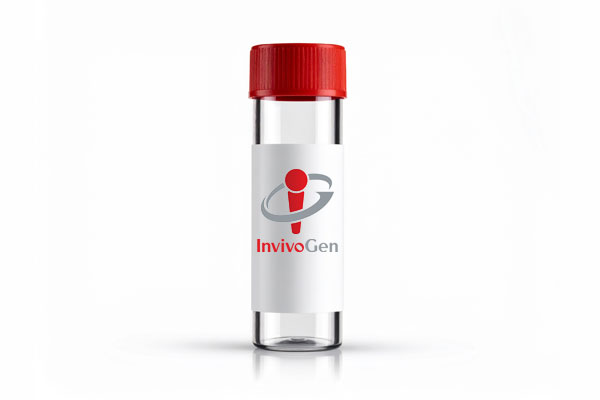Ferrostatin-1
-
Cat.code:
inh-fers1
- Documents
ABOUT
CAS #347174-05-4 - InvitroFit™ - Cell culture-tested
Ferrostatin-1 (Fer-1) is a strong, synthetic inhibitor of ferroptosis, a form of non-apoptotic cell death triggered by lipid peroxidation. It is an active radical-scavenger antioxidant that traps lipid reactive oxygen species (ROS) and thus, serves as a potential inhibitor of ferroptosis [1].
Mode of action
Ferrostatin-1 functions by scavenging lipid peroxyl radicals and preventing oxidative membrane damage, thereby protecting cells from iron-dependent oxidative stress and subsequent ferroptotic cell death [1].
Upon stimulation of our Ferroptosis reporter HT-1080 cells using the ferroptosis activator RSL3, the cell membrane ruptures and the reporter protein HMGB1::Lucia is released in the extracellular milieu. Levels of HMGB1::Lucia in the supernatant can be readily monitored by measuring the light signal produced after the addition of QUANTI-Luc™ 4 Lucia/Gaussia, a Lucia® luciferase detection reagent. Ferrostatin-1 successfully inhibits RSL3-induced ferroptosis and HMGB1::Lucia release (see figure). Moreover, ferroptosis inhibition in this cell line can be assessed using the classic cytotoxic lactate dehydrogenase (LDH) assay (see figure).
Key features
- Each lot is functionally tested and validated.
- The absence of endotoxin is determined using the EndotoxDetect™ assay.
- InvitroFit™ grade: each lot is highly pure (≥95%) and functionally tested
All products are for research use only, and not for human or veterinary use.
InvitroFit™
InvitroFit™ is a high-quality standard specifically adapted for in vitro studies of inhibitors. InvitroFit™ products are highly pure (≥95%) and guaranteed free of bacterial contamination, as confirmed using HEK Blue™ TLR2 and HEK Blue™ TLR4 cellular assays. Each lot is rigorously tested for functional activity using validated (or proprietary) cellular models. This grade ensures reliability and reproducibility for your research applications.
SPECIFICATIONS
Specifications
Lipid peroxyl radicals
C15 H22 N2O2
20 mg/ml in DMSO
10 nM - 10 µM
Negative (tested using EndotoxDetect™ assay)
Ferroptosis inhibition in cellular assay
Ferroptosis inhibition
Each lot is functionally tested and validated.
CONTENTS
Contents
-
Product:Ferrostatin-1
-
Cat code:inh-fers1
-
Quantity:10 mg
Shipping & Storage
- Shipping method: Room temperature
- -20 °C
- Avoid repeated freeze-thaw cycles
- Protect from light
Storage:
Caution:
Details
Ferroptosis overview
In 2012, Dixon et al. [1] discovered a novel form of non-apoptotic cell death characterized by iron overload and accumulation of lethal lipid peroxidation [2]. Because iron chelators were shown to block this type of regulated cell death, it was originally defined as iron-dependent and was called "Ferroptosis" [1]. In contrast to apoptosis, necrosis, and autophagy, ferroptosis is characterized by the build-up of lipid reactive oxygen species (ROS) triggering membrane damage. Cells undergoing ferroptosis do not exhibit classic apoptosis-like features, such as chromatin condensation or membrane blebbing. Instead, mitochondrial shrinkage and increased membrane density are often observed [1-2].
Ferroptosis is regulated by a complex network involving iron homeostasis, lipid metabolism, and glutathione-dependent oxidative-reductive balance [3-4]. Iron metabolism plays a central role, as excessive intracellular iron promotes the Fenton reaction, generating lethal amounts of ROS that drive lipid peroxidation [4]. Moreover, the enzyme glutathione peroxidase 4 (GPX4) is a key regulator that protects cells from ferroptosis by reducing lipid peroxides. GPX4 activity is dependent on Glutathione (GSH) which is synthesized using cystine imported via the cystine-glutamate antiporter, System Xc−. When System Xc− is inhibited, cystine uptake decreases, leading to GSH depletion and GPX4 inactivation. As a result, lipid peroxides accumulate in the cells ultimately leading to ferroptotic cell death [2-4].
Ferroptosis in disease
Ferroptosis is involved in various diseases, including neurodegenerative disorders, organ injury-related conditions, and cancer [2-3]. In neurodegenerative diseases, such as Parkinson's and Alzheimer's, ferroptosis contributes to neuronal loss through iron deposition in the brain and oxidative stress [3]. It has also been identified as a major pathogenic driver in other organ injury-related disorders including acute kidney injury and COVID-19-induced myocarditis [3]. Studies have shown that using ferroptosis-specific inhibitors can protect against severe tissue damage in these cases [3]. On the other hand, triggering ferroptosis is being explored as a potential therapeutic approach for treating therapy-resistant cancers [1-4]. Certain types of cancer, especially those with high iron levels or deficiencies in GPX4, are particularly sensitive to ferroptosis-inducing substances. Compounds like RSL3 or Erastin hold promise to overcome drug resistance in chemotherapy and immunotherapy [2]. Advancing our understanding of ferroptosis will continue to drive progress in cell death research and therapeutic development.
References
1. Dixon SJ, et al., 2012. Ferroptosis: an iron-dependent form of nonapoptotic cell death. Cell. 2012 May 25;149(5):1060-72.
2. Du Y, Guo Z. 2022. Recent progress in ferroptosis: inducers and inhibitors. Cell Death Discov. 8(1):501.
3. Sun S, et al., 2023. Targeting ferroptosis opens new avenues for the development of novel therapeutics. Signal Transduct Target Ther. 8(1):372.
4. Li J, et al., 2020. Ferroptosis: past, present and future. Cell Death Dis. 11(2):88.
DOCUMENTS
Documents
Technical Data Sheet
Validation Data Sheet
Safety Data Sheet
Certificate of analysis
Need a CoA ?







